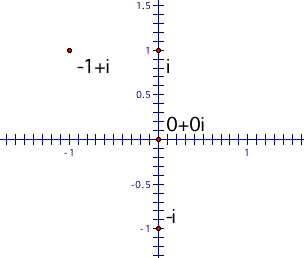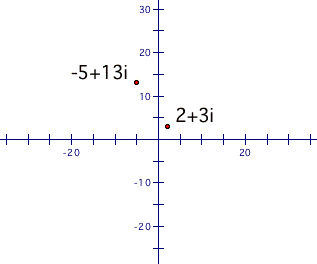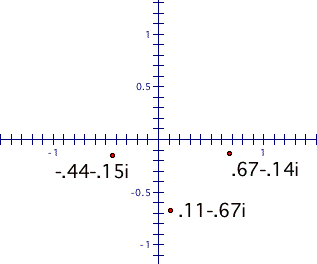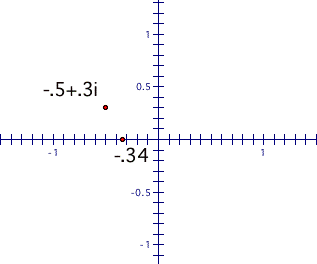Complex numbers and fractals solutions
3. This shows how to check for whether points are in a Julia set by iterating.
12-15 are for the Julia set for the complex number i, so we iterate using the
function: z2+i
Iterating 0: Easy enough for a quiz
First square it (multiply by itself): 0*0 = 0 then add i:
0 + i = i
Second iteration: i*i + i= –1
+ i = -1 + i
Third iteration: (-1 + i)(-1 + i) + i
= (-1)(-1) + (-1)i + i(-1) + i*i + i = 1 - i
- i - 1 + i = -2i + i
= -i
this doesn’t seem to be getting much bigger. It looks bounded
If you plotted these points, it would look like:

Iterates of 2+3i: The first two are easy enough for a quiz, but the third
is too messy
First iteration: (2 + 3i)(2 + 3i) + i
= 2*2 + 2 + 3i + 3i*2 + 3i*3i + i = 4 + 6i +
6i - 9 + i = -5 + 12i +
i = -5 + 13i
Second iteration; square: (-5 + 13i)(-5 + 13i) +
i = (-5)(-5) + (-5)13i + 13i(-5) + 13i*13i +
i = 25 - 65i - 65i -169 + i = -144 - 130i
+ i = -144
- 129i
Third iteration: (-144 - 129i)(-144 - 129i) +
i = (-144)(-144) + (-144)(-129i) + (-129i)(-144) + (-129i)(-129i) +
i = 20736 + 18576i + 18576i - 16641 + i
= 4095 + 37152i = 4095 + 37153i
this one is definitely headed out to infinity.
If you plotted the first two of these points, it would look like:

Iterates of 1-i: This would be good for a quiz
First iteration: (1 - i)(1 - i) + i
= 1*1 + i(-i) + (-i)1 + (-i)(-i) + i = 1 - i
- i - 1 = -2i + i
= -i
Second iteration: (-i)(-i) + i= -1
+ i = -1 + i
This is the same thing I started with, so the next iterate has to be –i
This one definitely doesn’t go out to infinity, because it keeps repeating
the same two numbers over and over.
4. # 11. Iterates of 0 using z2+.27 This might be too easy for
a quiz, because there are no i's
First iteration: 0*0 + .27
= .27
Second iteration. .27*.27 + .27 = .0729
+ .27 = .3429
Third iteration. .3429*.3429 + .27
= .11758 + .27 = .38758
This one looks bounded. (This is kind of a trick problem. It turns out that
this one goes to infinity, but we'd have to do a bunch more iterations to
know that.)
Starting with .5+.5i, rounded to 3 decimal places:This would be OK
.27+.5i
.093+.27i
.206+.05i (this looks bounded (nothing bigger than one)
5. # 20. Iterates of 0 using z2+.11-.67i A bit messy
First iteration. 0*0 + .11 - .67i
=.11-.67i
Second iteration. (.11-.67i)(.11-.67i) + .11
- .67i =.11*.11+.11(-.67i)+(-.67i)(.11)+(-.67i)(-.67i) +
.11 - .67i =.0121-.0737i-.0737i-.4489 + .11 -
.67i = -.4368-.1474i + .11 -
.67i = -.3268-.8174i
Third iteration. (-.3268-.8174i)( -.3268-.8174i) +
.11 - .67i =...= -.5613+.5343i +
.11 - .67i =.6713-1357i
which does not seem much closer to infinity than the first iteration, so I
don’t think this one is going off to infinity
#21: .11-.17i
.093-.707i
-.382-.801i This appears to be bounded (nothing over 1)
22: 1.11-.67i
1.34-.216i.
1.85-.644i This appears to be bounded (nothing greater than 1)
If you plotted these points (# 20), it would look like:

5b. Start with 0, using the function z2+(-.5+.3i) A problem
a lot like this one will be on the quiz
First iteration: 0*0 + -.5
+ .3i = -.5 + .3i
Second iteration:
(-.5 + .3i)(-.5 + .3i ) + -.5 + .3i =
(-.5)(-.5) + (-.5)(.3i) + (.3i)(-.5) + (.3i)(.3i) +
-.5 + .3i
= .25 - .15i - .15i - .09 + -.5 + .3i = .25 -
.09 - .15i - .15i + -.5 + .3i = .16 - .3i
+ -.5 + .3i = .16 - .5 - .3i
+ .3i = -.34
If you plotted these points, it would look like:




